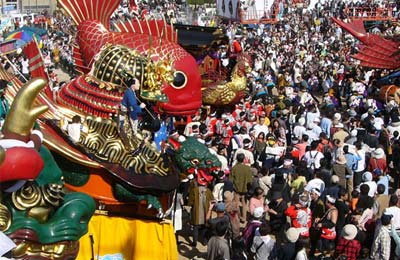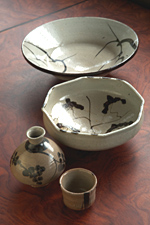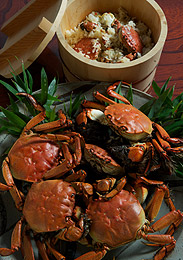Web Japan > Trends in Japan > Food & Travel > Karatsu
Karatsu
Historic Castle Town by the Sea
Karatsu is a quiet, historic city on the coast of the Genkai Sea in northwestern Kyushu. Several thousand years ago, the Genkai Sea was a well-traveled route that linked the Japanese islands with the Asian continent. In this area, rice paddies thought to be approximately 2,700 years old have been excavated, indicating that it was one of the earliest places in Japan to take advantage of the wet rice cultivation techniques imported from the continent. The Chinese historical work Records of Three Kingdoms chronicles the fact that a small country called Matsura-koku existed here in the 3rd century. The name Karatsu (literally, port to China and the Korean Peninsula) was first recorded in the 17th century.
The Bountiful Sea and the Beautiful Pine GroveThe port of Karatsu can be reached in about an hour by train from Fukuoka, Kyushu's largest city, but the blue of the sea is shielded from view by a thick grove of Japanese black pine trees. This pine grove is known as Niji-no-Matsubara (Rainbow Pine Grove), and it winds in a gentle curve along the white beaches and seacoast for approximately five kilometers. It was originally planted and cultivated in the 17th century by the lord of the Karatsu clan as a protective barrier against the wind blowing in from the sea.
The best way to enjoy the beauty of the pine grove is to climb nearby Mount Kagami-yama, a mountain to the south. Looking straight down from the top of the mountain, the green of the pines, the white of the beach, and the blue of the sea spread out in all directions. And on the left, Karatsu's town and castle, which jut out into the sea, can also be seen.
Lavishly Decorated Floats: The Hikiyama of the Karatsu Kunchi Festival
After arriving at Karatsu Railway Station, the visitor is greeted outside by a bronze statue of an enormous lion. This lion is modeled after a hikiyama float used in the Karatsu Kunchi Festival. This festival, which takes place every year from November 2nd to 4th and always enthralls local citizens, has its origins approximately 190 years ago in an agricultural festival held to thank the god of Karatsu Shrine for good harvests. In addition to lions, the floats are made in the shape of enormous sea bream, samurai helmets, and other unique designs, and they are drawn through the streets every year during the festival. Each year, many visitors who come from around the country enjoy the energy and excitement of the festival.
Karatsu Shrine is just a 10-minute walk from the railway station. Except for the three days when the festival is held, the floats—each over five meters tall—are displayed beside the shrine all year round. Each float is made of washi, or traditional Japanese paper, which was molded around a framework of wood or clay and then colored with lacquer or paints in red, blue, and gold. Every float is over 100 years old, and they are paraded through the streets during the festival to the sound of flutes, bells, and drums in a thrilling procession.
Ceramics Born in a Castle Town
Moving from the shrine toward the ocean, the visitor will come upon the castle tower of Karatsu Castle atop a small hill. Looking down from the castle tower, Niji-no-Matsubara and the white beach seem to stretch out like wings below.
Karatsu is a walking town, as it still retains the calm, relaxing atmosphere of its bygone castle town days. A look around reveals a Western-style bank and a traditional Japanese inn, both over 100 years old, and there is also a mansion built by a local coal-mining industrialist in the late 19th century. Although they have long since ceased operation, there were once coal fields near the port of Karatsu that were the source of wealth for local industrialists. Another attraction that shouldn't be missed on a walk through Karatsu is the Karatsu ware pottery shops. Since the late 16th century, ceramics ranging from everyday cups and bowls to fine art items used in the traditional tea ceremony have been produced in Karatsu. One of the most beloved types of Karatsu ware is the so-called e-garatsu, ceramic pieces that are known for their subdued colors and earthy texture, onto which are painted flowers and birds in glaze. Among the kilns in Karatsu is that of Nakazato Taroemon, who was appointed as a purveyor to the local Karatsu clan in the early 17th century. The current master ceramicist there represents the 14th generation, and his kiln has a gallery that is open to visitors.
Enjoy the Local Cuisine in KaratsuEveryone enjoys a good meal after a long walk, and tsugani, a type of crab that inhabits rivers, are a popular delicacy obtained in the Tamashima River, which flows into Karatsu Bay. The orange kanimiso (a miso-like edible paste found in crabs) and tender white meat are so delicious that it is hard to stop eating after trying just one. Kanimeshi (crabmeat rice) is also recommended. Karatsu is also known as one of the places where Japanese Black Cattle are raised. The meat, which is local delicacy in Saga Prefecture, is sweet and tender and is perfect for shabu-shabu. Twenty minutes by car to the northwest of Karatsu Castle is Yobuko, a port town where pure white squid are a popular delicacy. Everywhere in Yobuko a visitor can see the squid that were caught that day spread out to dry. And every day of the year except for New Year's Day, a morning market is held where fresh fish, shellfish, and vegetables are on sale. A wide variety of the local Genkai Sea delicacies—including sushi, boiled foods, and soups—are also available.
It seems that the charms of Karatsu beckon visitors from around Japan and abroad as an historic town on the coast of the Genkai Sea that is rich in natural beauty and delectable delicacies, in addition to its tranquil streets and unique cultural characteristics.
(March 2012)
- Kagoshima (August 2011)
- Fukuoka, a Center of History and Culture (March 2010)









